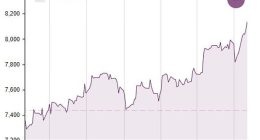
Nielsen plans to include digital and streaming audiences in its main ratings product.
Photo: PHOTO: JEWEL SAMAD/AGENCE FRANCE-PRESSE/GETTY IMAGES
Nielsen said it would replace its current TV ratings system by 2024 with a metric that incorporates digital viewing including streaming TV as well as the current traditional audiences, a shift that could transform how TV and digital video ads are bought and sold in the future.
But as the TV industry’s top measurement firm tries to catch up with the way audiences watch now, it will require the approval of TV networks, walled-off tech giants and advertisers. Nielsen will also have to integrate its technology across different platforms and data sources to ensure that the information it reports is comparable across different screens, platforms and content types, industry executives said.
At stake is more than $60 billion that is spent on TV ads in the U.S. every year, as well as tens of billions of additional dollars for digital video and streaming ads.
Nielsen plans to introduce the new measurement product in the fourth quarter of 2022 and secure its adoption by ad sellers and buyers by the start of the fall 2024 TV season. In 2021, the firm plans to start previewing the new data alongside the existing ratings product.
“2024 is when we take away the old stuff and just do it in this new way,” said David Kenny, chief executive of Nielsen.
Nielsen hopes ad buyers and sellers transition to the new system earlier, but they will need to review the new data and incorporate it into their ad-buying and -selling processes before that happens, Mr. Kenny said. “I don’t think we can make a change of this magnitude that affects over a $100 billion of trading without giving the market notice and the chance to compare data and workflows,” he said.
Nielsen said last month that it would soon shift from averaging viewers for all commercials within a TV program to measuring each ad individually. It also intends to begin measuring targeted commercials—when different households see different ads based on audience data—on a national basis. Marketers and TV networks have blamed the lack of national metrics on targeted TV ads for holding back the growth of such ads.
“It’s measuring TV more in the way digital is measured,” Mr. Kenny said of the new metric.
Nielsen has secured deals with owners of set-top boxes and smart TVs to bring in viewership data to help make the changes possible, the company said. It will need to secure more such partnerships, said Adam Gerber, global chief media officer for ad agency Essence, a part of WPP PLC-owned GroupM.
Nielsen said it would also change its audience panels, a key tool in Nielsen’s traditional TV ratings over the decades, to track viewership across devices including internet-connected TVs, mobile devices and computers.
The ability to merge the differences between the way TV and digital media ads are bought and sold has long been seen as critical among ad buyers and sellers, and Nielsen has been under pressure to improve its capabilities to address changing video viewing habits.
“This was a move that had to be made because the industry is at a breaking point in terms of its ability to function in this new environment that we live in,” said Mr. Gerber. “For upwards of a decade now we have been trying to cobble together two different measurement approaches, and it doesn’t work.”
Ultimately, Nielsen’s goal is to provide the media and ad industries with the ability to compare, for example, the metrics on the same ad that ran inside an hour-long TV episode and before a shorter video on YouTube.
But it is also going to need ad sellers and platform owners, including TV networks with major streaming services, social video tech giants and streaming-TV distributors, to play ball and be willing to share their data. As one ad-buyer who oversees more than $100 million in TV ad spending every year said, “Are the walled gardens OK with this?”
Representatives for TV-network groups and major ad-buying firms including Comcast Corp.’s NBCUniversal, ViacomCBS Inc., and Omnicom Group Inc.’s OMG declined to comment on Nielsen’s announcement. Roku Inc. and Amazon.com Inc., two big streaming platform operators, and Facebook Inc., also declined to comment.
Some executives said they plan to meet with Nielsen to get more details on the measurement firm’s timeline and how the technology and methodology underpinning the changes would work.
Any big change in the TV advertising system will take some time as ad sellers and buyers try to update their systems, workflows and tools and get more comfortable with new processes, said Jane Clarke, chief executive of the Coalition for Innovative Media Measurement, an industry trade group that advocates for better audience measurement.
They will also want to get preview data from Nielsen to see how adopting the new system would affect their businesses.
“When you change the currency, it’s a business decision,” Ms. Clarke said. “It’s not just a simple measurement thing; it changes all the rates you pay for everything.”
“The TV industry is gradually bringing in digital concepts like data, addressability and ad measurement, but they are doing it very slowly, so they don’t lose the emphasis on process, the emphasis on high-quality content, and so they can understand the business implications with every step they take,” she added.
Nielsen executives said the firm is working with the Association of National Advertisers, TV ad sellers and other groups to support the transition it is planning.
Earlier this fall, Nielsen announced deals with YouTube, part of Alphabet Inc.’s Google, and Vizio Inc. to measure ad campaigns on their streaming TV platforms. Nielsen said it would seek direct integrations with other digital platforms, including social media operators and streaming-TV providers.
Such companies have often held their user data close, and it is unclear whether they would be willing to provide enough information to cleanly compare viewership across different devices and platforms.
Nielsen said its new system will require sellers to produce a certain set of metrics, which will be audited and accredited by industry watchdog Media Rating Council, to ensure that everyone is on an equal playing field.
These companies also have an incentive to be measured with the same yardstick as television, according to Mr. Kenny.
“They are looking for third-party measurement because there is credibility in third-party measurement,” he said.
Write to Sahil Patel at [email protected]
Copyright ©2020 Dow Jones & Company, Inc. All Rights Reserved. 87990cbe856818d5eddac44c7b1cdeb8









